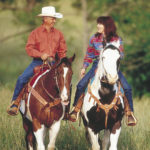Every rider, at every level, falls off at some time, so look for a helmet that’s ASTM/SEI certified. ASTM is the American Society for Testing and Materials, which sets standards for helmets; SEI is the Safety Equipment Institute, which certifies that helmets meet those standards.

Even the best safety helmet won?t protect your head if it doesn’t fit properly. And a bad fit can be dangerous, especially if the helmet slips down, blocking your vision. Here are four fit tips:
Put your helmet on right: Make sure the helmet is level?the visor shouldn?t tip up or down. If you have long hair, tie it back at the nape of your neck?don’t shove it under the helmet, or you’ll get a poor fit. Fasten the harness, making sure it’s comfortably snug.
Check the fit of your riding helmet: Make sure the helmet fits snugly all the way around. Wiggle it back and forth and side to side; when it moves, your scalp (and your eyebrows) should move with it. If it slides freely, you need a smaller size. If it squeezes uncomfortably, go up a size.
Check the shape of your riding helmet: If the helmet squeezes your brow but still rocks freely side to side, it’s too round for your head; if it fits at the sides but rocks back and forth, it’s too oval. Many helmets come with fitting pads you can slip into the inside hatband to solve these problems. For example, if the helmet is too round, put a pad on each side. Or, try a different style with a more or less oval shape.
Check the brim of your riding helmet: The helmet?s brim should rest ?? to 1 inch above your eyebrows. If it sits higher, you’re not getting full protection; any lower, and it could obscure your vision. Some helmets can be adjusted (with lacings or foam pads) to rest lower or higher. Or, try a style with a deeper or shallower crown.
This article first appeared in Horse & Rider magazine and is in the Tractor Supply Company’s “Trail Riding Essentials.”





